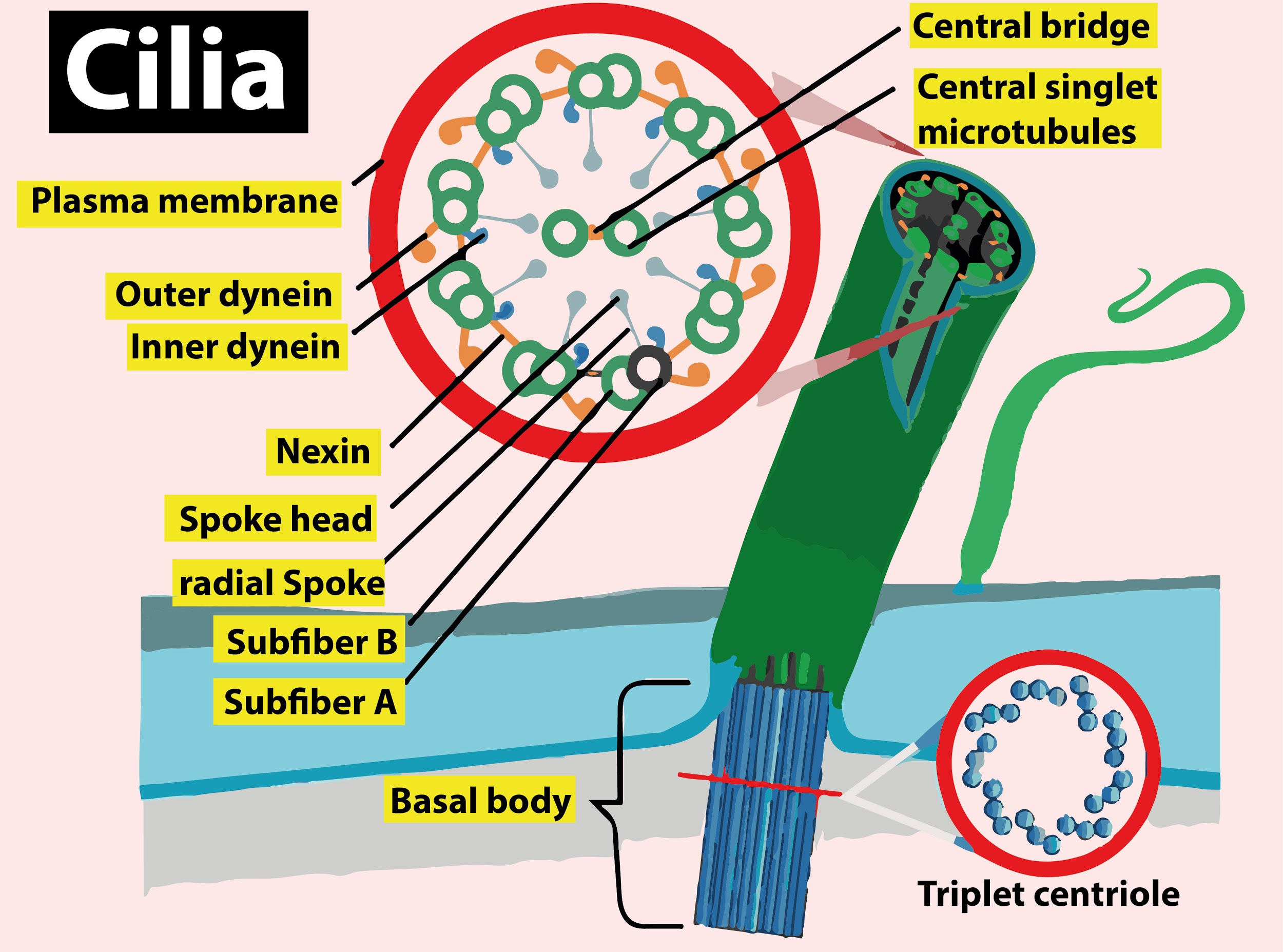
Axoneme with 9 + 2 microtubule arrangement occurs in
(a) Cilia
(b) Flagella
(c) Both A and B
(d) Centriole
Answer
507.3k+ views
1 likes
Hint: Axoneme with 9 + 2 microtubule arrangement occurs in cellular appendages which helps in the functions related to locomotion of the organism or movement of any particles through its body. The axoneme forms their core in which protein filaments are arranged in a particular fashion.
Complete answer:
Eukaryotic flagella and cilia share a common structural organization of 9+2 arrangement. Their core is called an axoneme. The axoneme consists of nine pairs of microtubule doublets arranged peripherally with a central pair of singlet microtubules. These bundles of microtubules comprising the axoneme are surrounded by a plasma membrane. Each doublet microtubule consists of A and B tubules made up of protofilaments. They are linked through a protein named ‘tektin.’ Adjacent pairs of doublet microtubules are joined through a linker made up of a protein called ‘nexin.’ A second linker also radiates from the central singlets to each A tubule of the peripheral microtubules. These linkers are known as radial spokes.

So, the correct answer is ‘Both A and B.’
Additional Information:
- A flagellum has a wave-like motion driving a cell in the same direction as the axis of the flagellum. A cilium generates alternating power and recovery strokes. These strokes move a cell perpendicular to the axis of the cilium.
- Cilia are many in number as compared to flagellum and occur all over the surface of the cell. A flagellum is usually longer and only 1 - 4 per cell.
- A centriole is a barrel- shaped polarized structure made up of microtubules. They are present mostly in animal cells and some fungi but not in plant cells. The walls of each are composed of nine triplet microtubules arranged peripherally without any central microtubules. The central part of the centriole is proteinaceous and called the hub, which is connected with the peripheral triplets via radial spokes made up of protein. This is known as the 9 + 0 arrangement.
Note:
- The cell organelle centrosome contains these perpendicularly arranged centrioles surrounded with a centrosome matrix.
- Prior to mitosis in animal cells, centrioles duplicate in a centrosome and later in the M- phase migrate to opposite poles. They initiate the process of bipolar spindle synthesis wherein they give rise to spindle fibers during cell division. They also form the basal body of cilia or flagella.
Complete answer:
Eukaryotic flagella and cilia share a common structural organization of 9+2 arrangement. Their core is called an axoneme. The axoneme consists of nine pairs of microtubule doublets arranged peripherally with a central pair of singlet microtubules. These bundles of microtubules comprising the axoneme are surrounded by a plasma membrane. Each doublet microtubule consists of A and B tubules made up of protofilaments. They are linked through a protein named ‘tektin.’ Adjacent pairs of doublet microtubules are joined through a linker made up of a protein called ‘nexin.’ A second linker also radiates from the central singlets to each A tubule of the peripheral microtubules. These linkers are known as radial spokes.

So, the correct answer is ‘Both A and B.’
Additional Information:
- A flagellum has a wave-like motion driving a cell in the same direction as the axis of the flagellum. A cilium generates alternating power and recovery strokes. These strokes move a cell perpendicular to the axis of the cilium.
- Cilia are many in number as compared to flagellum and occur all over the surface of the cell. A flagellum is usually longer and only 1 - 4 per cell.
- A centriole is a barrel- shaped polarized structure made up of microtubules. They are present mostly in animal cells and some fungi but not in plant cells. The walls of each are composed of nine triplet microtubules arranged peripherally without any central microtubules. The central part of the centriole is proteinaceous and called the hub, which is connected with the peripheral triplets via radial spokes made up of protein. This is known as the 9 + 0 arrangement.
Note:
- The cell organelle centrosome contains these perpendicularly arranged centrioles surrounded with a centrosome matrix.
- Prior to mitosis in animal cells, centrioles duplicate in a centrosome and later in the M- phase migrate to opposite poles. They initiate the process of bipolar spindle synthesis wherein they give rise to spindle fibers during cell division. They also form the basal body of cilia or flagella.
Latest Vedantu courses for you
Grade 9 | CBSE | SCHOOL | English
Vedantu 9 CBSE Pro Course - (2025-26)
School Full course for CBSE students
₹37,300 per year
Recently Updated Pages
Master Class 11 Computer Science: Engaging Questions & Answers for Success

Master Class 11 Accountancy: Engaging Questions & Answers for Success

Master Class 11 Physics: Engaging Questions & Answers for Success

Master Class 11 Business Studies: Engaging Questions & Answers for Success

Master Class 11 Maths: Engaging Questions & Answers for Success

Master Class 11 Chemistry: Engaging Questions & Answers for Success

Trending doubts
How much is 23 kg in pounds class 11 chemistry CBSE

What was the first capital of Magadha APatliputra BVaishali class 11 social science CBSE

How does Amoeba obtain its food a Endocytosis b Exocytosis class 11 biology ICSE

What is the molecular weight of NaOH class 11 chemistry CBSE

What is food class 11 biology CBSE

Write the differences between monocot plants and dicot class 11 biology CBSE




